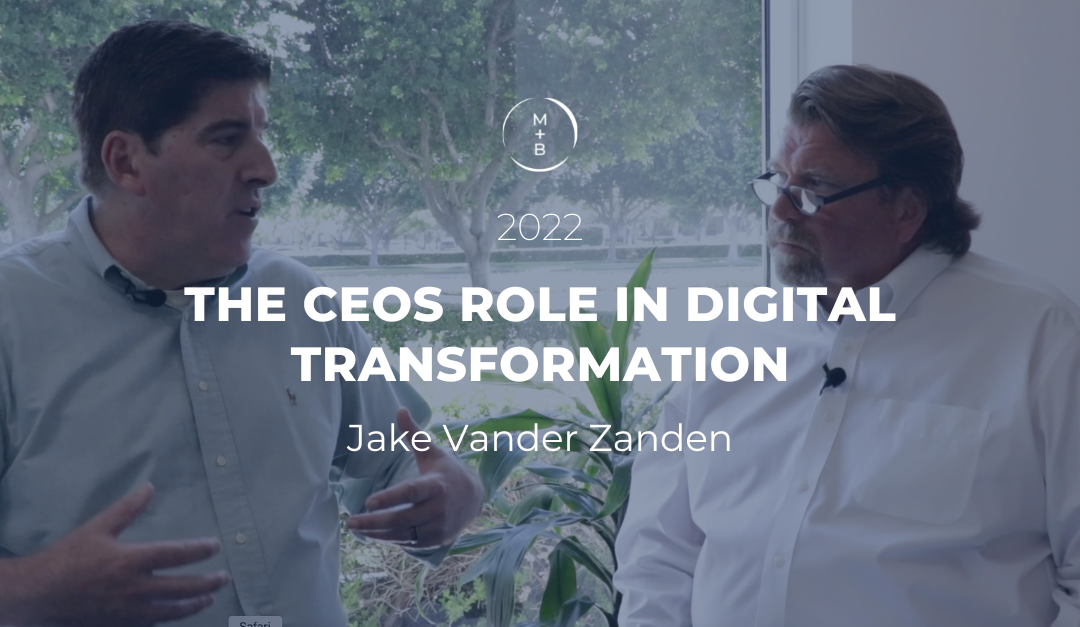In my recent conversations with senior leaders, I’ve noticed there is a lot of talk about digital transformation, and many CEOs are struggling to figure out where they fit within this. The CEO’s responsibility is to serve as the heartbeat of an organization, driving culture from the top down, owning and meeting key business objectives, and influencing internal and external stakeholders to achieve results. But, how does this translate to digital transformation?
To gain a deeper understanding of the CEO’s involvement and relationship with digital transformation, I decided to sit down and chat with my friend and colleague, Mike Stephens. Mike is a digital transformation expert and has helped companies in life sciences, finance, manufacturing, and retail deploy digital technologies and execute their digital transformation strategies. So, I asked Mike, “What is the role of the CEO in digital transformation, and how can they support it on top of all their other responsibilities?”
Firstly, Digital Transformation is not just about the technology. That’s part of it, but it shouldn’t be the whole focus. It’s about integrating technology in every facet and function of an organization to collect data and information from people machines and physical and digital processes, and then use this data to sustain and grow your company. Who better understands and drives that mission than the CEO? The CEO is the glue that holds an organization together.So, naturally, they will be a key player in digital transformation, but the real job for the CEO is to focus on three key things: culture, people, and innovation.
Mike Stephens
Culture
As we all know, culture comes from the top down in every organization. When it comes to digital transformation, the CEO’s job is to drive a culture that values agility, change, and a data-driven approach to working. When we talk about a “data-driven culture,” this means a lot of different things to different people across the organization. For example, a marketing team’s key performance indicators will be significantly different from those in operations or customer experience. But the real responsibility for the CEO is to create a culture of curiosity, where everyone across the organization is inspired to look at where and how technology can enable and drive their specific business goals.

Talent and Leadership
Another job for the CEO is to have the right leaders in place that can recognize and tie digital transformation into the vision, purpose, and mission of what they do everyday. To support driving a culture of curiosity that permeates the entire organization, the CEO needs to surround themselves with leadership and talent that are agile and inquisitive. Someone within each department has to unpack what data is important to their team and how the company will act on this data to proactively solve problems. The CEO will need big picture thinkers that ask great questions and get involved with the ‘why’ of a strategy. This type of talent is a rare find and these employees are often change-makers, collaborative thinkers, incredibly passionate, and transformative in their approach as well as the work they do. While this leadership talent, including the CEO, does not necessarily need to be a digital native, they all must be committed and connected to the digital transformation strategy, pinpoint where it can support and grow their functional or departmental KPIs, and lead the team in that direction.
Innovation
Aside from building a culture of curiosity with the right team in place, it is the CEO’s responsibility – in the early stages of innovation – to be the voice for mission critical business goals. Innovative strategies and collaborative discussions will often produce a lot of new ideas and potential directions that digital transformation can head. The CEO must always keep the end result in mind by asking “What are the results we want, and why are we doing this?” When it comes to the innovation conversation and planning for digital transformation, the CEO can lean on the Chief Digital Officer (CDO) or an external Digital Transformation Consultant to define and structure the best approach for execution and implementation.
Digital Transformation and A.I. in Life Sciences Today
As I was thinking about leadership and innovation, I shared with Mike a few examples in life sciences where I’ve seen digital transformation successfully implemented. One company in particular specializes in gene therapy and, through digital transformation, collects genetic data from patients and uses this data to alter patients’ blood to treat for very specific diseases with a 24-hour turnaround. This is possible due to the collection of data in real-time from multiple data sources, the ability to quickly synthesize this information, make preliminary decisions, and act quickly to provide better treatment.
In another example, a life sciences company collects colonoscopy data from hundreds of thousands of patients and uses artificial intelligence (A.I.) to determine which lesions or polyps need to be removed and which ones do not, since removing some may do more harm to a patient than good. As a result, A.I. has become more precise in its diagnosis than a doctor’s, which yields better patient outcomes – all driven by data. Mike shared his thoughts on these examples and added,
Again, technology and data is the enabler here. But the main focus, especially for the CEO, should always be on the end result – whether it’s through gene therapy or more accurate diagnoses. The reason digital transformation fails is because people become too enamored and focused on the technology and start trying to fit the technology into their processes where it doesn’t belong or work. The real core of digital transformation, including these two examples you mentioned, should always be the end result, and the CEO’s job is to advocate for this in every stage of the process, whether it’s better patient outcomes, success rates, or business growth.
Mike Stephens
Where the CEO Begins
Digital transformation is a massive undertaking and an overwhelming initiative presented to CEOs. My conversation with Mike was incredibly insightful, but I couldn’t help but think to myself, “If I was the CEO at a life sciences company, and I knew that digital transformation was the next step – where would I even start?” Mike elaborated and reinforced his prior points about the CEO serving as the fulcrum for change, saying:

I can’t emphasize enough the CEO’s role in all of this is to focus on setting the culture, spending the time to plan, realizing it’s a journey, and involving the right talent in this journey. First, it takes a village to go through a digital transformation. But, always start with the end goal in mind – the WHY. Start with an assessment of the digital maturity level of your organization by asking ‘Where are we now and where do we need to get to?’ Second, you are not alone in this journey. There are partners and consultants out there that understand your business and can help you with best practices and clear pathways to achieve the desired outcomes. Start with the strategic plan, and once everyone culturally buys into and understands what that is, the software, platforms, partners, stakeholders, vendors and most importantly technology will all fall into place.
Mike Stephens
Continuing the Conversation
There were many other things that Mike and I discussed during our conversation on digital transformation. To learn more and watch my interview with him, click here.
Jake Vander Zanden
Partner
(949) 541-5000
jake@mbexec.com
Jake Vander Zanden serves as a Partner and leader of McDermott + Bull’s Technology + Life Sciences Practice.
Jake spent over 25 years as a turnaround and growth leader completing business transformations as a senior executive at companies like Allergan, Medtronic, and more. He has lived and worked throughout Asia, Africa, and Europe, and managed businesses in all the major regions of the world. Jake’s success has come from his ability to quickly and continuously develop high performing teams and guide their achievement of company changing initiatives, regardless of country, language, culture, or product group.


